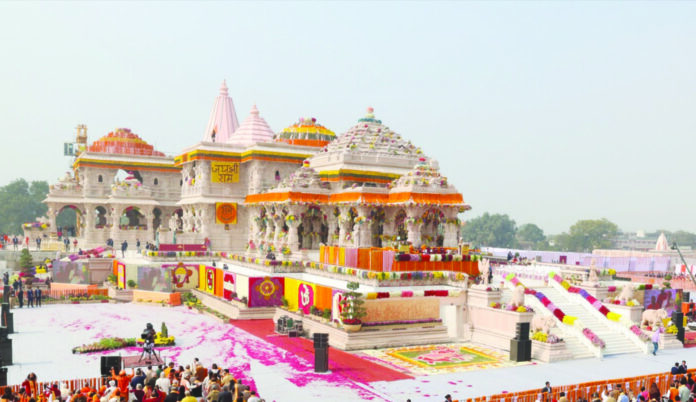Just this week, the BJP’s pet project achieved fulfilment in the inauguration of the Ram Mandir at Ayodhya. Aside from beaming film stars and decorated pandits, the event was obviously political in nature.
It’s election year, not that Rahul Gandhi’s INDIA coalition needs any encouragement to go all out. The stakes are already too high. I’m certainly not the first person to explore the explosive rise of Hindu nationalism, the deliberate confusion of mythology and history about Ayodhya, Ram and the Babri Masjid, nor even the role of nationalism in helping populists do their bidding.
But militant Hindu nationalism cannot be born in vacuum, it needed first the existence of Hinduism as a coherent and unified religious organization, or Church as Durkheim called it.
It might be worthwhile, therefore, to trace the “creation” of Hinduism, long before BJP came to the fore.
And, as always, etymology is our guiding friend. The term “Hinduism” is largely a modern construct, and there is no evidence to suggest that South Asians who we now call ‘Hindus’ identified with it in the mediaeval or prehistoric age. The word is absent in the Vedas, the oldest surviving text in South Asia. Thankfully for our understanding, Narayan Jha has held that where this term is used in ancient records, it alludes to geography, not religion.
Some have held that Hindu comes from Sindhu, which refers to River Indus. Thus, Persian and Arab chroniclers noted the demarcation between ‘Sind’ and ‘Hind’ being the Indus-Sarasvati area. As the borders of the Achaemenid and, later, Arab empires ended roughly at what is today Pakistani Sindh, the area beyond it became Hind, or Hindustan. A lot of people, including me until recently, believed this meant ‘the land of the Hindus’. And by Hindus, we meant those adhering to a particular religion we call Hinduism.
But what really is a religion? Can we apply a European metric to a part of the world Chaudhary Rehmat Ali called Dinia (literally ‘abode of deens’)? Not quite. For one, there is no accurate translation for the word in Sanskrit. Dharm cannot be equated to a religion, it is a moral framework for life. Thus, Krishna steels Arjuna’s resolve in Mahabharata’s Bhagavad Gita that fighting and killing his cousins and other family members and friends was his dharm, his duty as a Kshatriya warrior.
In any case, even Islam does not claim to be merely a religion but a deen, a complete code of life. On another level, several religious movements emerged as a challenge to Brahminic-Sanskriticism (yes, that would be the accurate term) and its varna hierarchy that informed jati – caste, that old evil. But adhering to different dharma did not mean they discarded the common Indic milieu and religio-philosophical grammar and vernacular.
In these desperate times, no one can afford to forget the colonial origins of modern Hinduism, whose inevitably militant and extremist version that is the RSS and BJP now threatens two billion South Asians. But repeating it can problematize this history and, hopefully someday, return creation back to the void from which it had emerged.
Thus, we see the existence and acceptance of Brahma in Buddhism, reincarnation and vegetarianism in Jainism and karma in Sikhism. This does not make these dharms ‘Hindu’ just because Siddhartha Gautama, Mahavira and Baba Guru Nanak knew of and used ‘Hindu’ terminology.
My point is the boundaries between Indic religions were much more fluid in the precolonial era than they are today. Sudipta Kaviraj uses the notion of fuzzy identities to describe this phenomenon in the premodern era. For instance, a Jain might be a regular temple-goer, and no one would bat an eye. ‘Hinduism’ itself was not a uniform set of beliefs that make up a religion in the European sense of the word, rather it was a collection or hotch potch of mingling and overlapping beliefs that Max Müller called henotheism: monotheism in principle and polytheism in fact. One could pray to Shiva while also nodding to Vishnu. It had the remarkable ability to act as a sponge to soak up developments anywhere in South Asia. An ancient Greece-styled pantheon of deities with neatly demarcated jurisdictions didn’t exist.
So, what changed? Even before the British Raj had been established, David Lorenzen has held Hinduism solidified in the interaction and conflict between Muslims and Brahminic-Sanskriticists between 1200 and 1500; Kabir’s poetry has traces of violent communal conflict.
Then, colonialism happened. The white man, hyped up on a rationalism-crazy, hopped around the world, trying to reimagine it in his own image. Along with not-so-subtle divide-and-rule, communal censuses were introduced. The Sikhs had to publish a pamphlet titled ‘We Are Not Hindus’ to show the gora sahib not everyone who didn’t pray in a Masjid became a Hindu by default. Even today, Wikipedia notes that 1.2 billion Earthlings are Hindus, with no distinction over whether one is a Shaivite or a Vishnavite, or even believing in someone/thing else.
An existing boundary was fossilized by the colonizer. This explains why the 1979 World Hindu Conference could not agree on a definition of Hinduism: delegates were trying to define something that had eluded one-dimensional definition for centuries. But just as the colonizer packaged every deen/dharm in South Asia into neatly separated containers, some religious groups helped them out. Organizations like the Arya Samaj and the RSS aspired to a unity that is more associated with Abrahamic monotheism by creating conversion rituals that had never existed because dharm had, for millennia, been associated with one’s jati. Of course, this process was not this simple; history is complex and often involves contingency and the existence of multiple factors.
But the clock had started. Hindu nationalism could not have been born without first the birth of the idea that a singular Hinduism existed (one should always be wary of something that ends with -ism). Saffron politics would have had no appeal without the receptors feeling a common loyalty to it. Benedict Anderson’s imagined community had been created. And it was on a dangerous path, for itself, others around it, the land itself and all its inhabitants.
History was reimagined as a neat classification into Hindu, Muslim and British eras. Whether or not a mandir had been demolished at Ayodhya to build a mosque, it was entrenched in popular imagination that the Muslims– not just Babur or his governor– dismantled a temple and built a mosque over it.
See it this way and it seems that Ayodhya was inevitable. Let there be no doubt about it– there will be more Ayodhyas in the future. Here, evidence was shaky but the confusion between mythology and history led the way. What about all the mosques, stupas and gurdwaras about which it is provable that they stand atop razed temples?
In these desperate times, no one can afford to forget the colonial origins of modern Hinduism, whose inevitably militant and extremist version that is the RSS and BJP now threatens two billion South Asians. But repeating it can problematize this history and, hopefully someday, return creation back to the void from which it had emerged.























